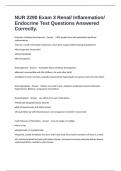NUR 2290 Exam 3 Renal/ Inflammation/
Endocrine Test Questions Answered
Correctly.
Disorders of Kidney Development - Answer •10% people born with potentially significant
malformations
•Can be a result of hereditary influences, most often acquired defect during development
•Renal Agenesis (no growth)
•Renal Hypoplasia
•Renal Dysplasia
Renal Agenesis - Answer •complete failure of kidney development
•Bilateral- incompatible with life (stillborn, die early after birth)
•Unilateral is more common, typically compensatory hypertrophy (one grows more than the other)
Renal Hypoplasia - Answer kidneys are small in size, unilateral usually discovered incidentally-
Hypertension, Bilateral - progressive renal failure
Renal Dysplasia - Answer can effect all or part of the kidney
•Multicystic dysplastic kidney disorder
•Risk of hypertension and Wilms tumors
•Annual follow-up with blood pressure and sonograms (6 months if concerned)
Cystic Diseases of the Kidney - Answer •Can be single or multiple
•Vary in size
•Symptomatic or Asymptomatic
•Acquired, usually hereditary (not born with it but most times family members will have it as well)
•Ex: autosomal dominant polycystic kidney disease, autosomal recessive polycystic kidney disease,
nephronophthisis, medullary cystic disease
,Autosomal Dominant Polycystic Kidney Disease (need 1 dominant gene) - Answer •Most common
inherited kidney disease
•Multiple expanding cysts destroy kidney structure and cause renal failure
•Manifestations: pain, hematuria (blood in urine), UTI's and Hypertension
•Ultrasounds and CT scans to diagnose
•Supportive care: control pain, UTI's and BP
Autosomal Recessive Polycystic Kidney Disease (need 2 recessive genes) - Answer •This is a childhood
kidney disease
•Manifestations present usually at birth with the infant progressing rapidly to renal failure
•Bilateral flank masses (usually located on lower back)
•Severe renal failure
•Impaired lung development
•Hypertension
•75% die during perinatal period
Nephronophthisis - Answer •Small kidneys
•Multiple cysts
•Usually juvenile
•Progresses to Chronic Kidney Disease
•Polyuria, polydipsia, enuresis (bed wetting)
Medullary Cystic Kidney Disease - Answer •Small kidneys
•Adult onset
•CKD
•Polyuria, polydipsia, enuresis (bed wetting)
Simple & Acquired Renal Cysts - Answer •Simple and Acquired Renal Cysts
, •May cause flank pain, hematuria, infection and HTN
•Common in people over 50
•US and CT scan
Acute Nephrotic Syndrome - Answer •Acute inflammatory process
•Can be post-infectious or secondary to systemic diseases such as SLE (systemic lupus erthyrematosus)
•S&S: sudden onset of hematuria, proteinuria, decreased GFR (globular filtration RATE) <60 , oliguria,
edema, HTN
SLE (systemic lupus erthyrematosus) - Answer an autoimmune disease in which the immune system
attacks its own tissues, causing widespread inflammation and tissue damage in the affected organs.
Acute Post Infectious Glomerulonephritis - Answer •Occurs after infections with certain strains of
group A β-hemolytic streptococci, 7-10 days post-infection
•Rare in industrialized nations but common in underprivileged populations
•S&S: oliguria, hematuria, edema (especially face and hands), HTN
•Treatment: ABX, supportive care, usually resolves
Acute Pyelonephritis - Answer •Etiology: bacterial infection usually E. coli
•Uncomplicated- no structural abnormality
•Complicated- structural abnormalities
•Acute Onset: shaking, chills, moderate to high fevers, constant ache in the loin and back area usually
unilateral. Dysuria, frequency, urgency
Treatment: antibiotics 10-14 days
Renal Failure - Answer •the kidneys fail to remove metabolic end products from the blood and regulate
the fluid, electrolyte and pH balance of the extracellular fluid
•Underlying cause could be renal disease, systemic disease or urologic defects from a non-renal origin.
•Acute Kidney Injury (AKI): abrupt onset, often reversible if recognized early
•Chronic kidney Disease (CKD):develops over the course of years, irreparable damage, can lead to the
need of dialysis




